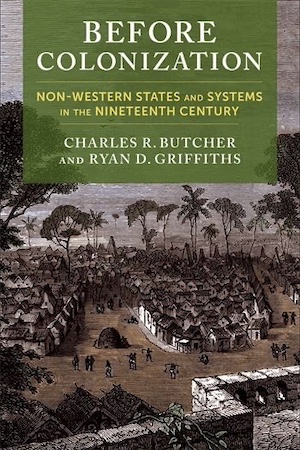Charles R. Butcher & Ryan D. Griffiths Colonization: Non-Western States and Systems in the Nineteenth Century Columbia University Press 344 pages 6 x 9 inches, ISBN 9780231219365
In a nutshell
This book corrects a Eurocentric picture of International Relations (IR) that has dominated the study of international relations over the past decades, and especially the statistical study of IR. If we were to ask a basic question like, how many “sovereign states” are there today, we could broadly agree on the answer because of sovereignty-attributing institutions like the United Nations. But if we were to ask how many states there were 200 years ago, in 1825, social scientists did not have a good answer. Although registers of sovereign states exist that cover the nineteenth century, these are heavily biased towards Europe and the Americas, representing the regions of Africa, Asia, and the Middle East as blank.
We know this picture is wrong, and using a new dataset on sovereign states in the 19th century, we show that places like South Asia, West Africa, and Southeast Asia were dense state systems. Indeed, when we correct existing biases in the field, there were more states in 1825 than there are today. We also quantify the scale of mass state death that occurred with the coming of European colonialism. We then zoom into East Asia, South Asia, Southeast Asia, and West Africa, asking what the states in these systems were like, did they rule as centralized governments, or was rule more decentralized? Since non-Western states have typically been excluded from systematic and comparative studies, we also ask whether some of the main theories of why states centralize their rule apply outside of the European context in which they were developed.
We find that most states ruled in a decentralized way through systems of vassalage that allowed local leaders a high degree of autonomy. This decentralized form of rule produced a different form of international system, one where states had fuzzy borders, power was more graded than uniform, and forms of overlapping sovereignty were more common. Moreover, we find that some of the most important theories of European state centralization don’t seem to apply – rather, factors like trade and war seem to have caused states to decentralize their rule as often as they caused centralization. We argue that basic limits on the ability to transport people, goods, and ideas that characterized the 19th century put a limit on the extent to which centralized states were able to form.
The wide angle
Our book relates to big questions such as what counts as a state in the international system and how many states there were at different points in time. These are basic and important questions because basic states are the unit over which we measure many things like democracy, conflict, or development, as basic as a square meter, a day, or a voting district. The exclusion of hundreds of states in the 19th century raises important questions about how well theories of – for example – the rise of the centralized state can generalize to regions outside of Europe.
The book also relates to broader questions and theories about why states sometimes centralize their rule. Centralization is when rulers remove the autonomy of local actors to decide their own laws, levy their own taxes, and keep their own militaries, and concentrate those decision-making powers in a central government. Some of the most influential theories in the field emphasize that European states centralized in response to pressures from war and incentives provided by trade (or a combination). But our findings suggest that these factors had mixed impacts on states in West Africa, South Asia, and Southeast Asia in the 19th century. Sometimes they produced limited centralization, but more often they caused further decentralization and the fragmentation of states. We argue that this is because of low levels of interaction capacity (the ability to move people, goods, and ideas), which make centralization projects expensive for state rulers and might even reverse the impacts that war and trade had on centralization in Europe.
The book is the product of more than a decade of work together. Our first attempt to create the dataset began with a book on the stamps of 19th-century states that no longer exist. It was a great find, and it reinforced our suspicion that there were previously many states and systems that were mostly ignored in the field of international relations. From there, we were able to obtain grants from the Australian Research Council, the European Research Council, and the National Science Foundation, and those grants enabled us to create large research teams. The work continues, and we are now creating data on related issues like conflict and precolonial legacies. It’s been a fascinating project.
A close-up
Page 6, which shows the difference between the number of states that are included in the data that underpin our book, compared to the number of states identified in existing data. The gap for the 19th century is very large, indicating the exclusion of hundreds of states from international relations research. Another favorite of mine would be page 166, which shows the states in West Africa and where they were located. It indicates how widespread and dense states were in this region before colonialism.
Most quantitative studies of war, diplomacy, and trade that include the nineteenth century are trained on a small and skewed sample of only about a tenth of the states that actually existed. Yet the world was filled with hundreds of states in the early 1800s, most of them in Africa and Asia, but these states largely disappeared by the beginning of the twentieth century in what may be the largest state extinction event in history. (page 6)
Lastly
We hope that it raises awareness of how different the interstate system looked two hundred years ago and what a major event the coming of European colonialism was. Just seeing how many states there were across the globe in the nineteenth century is sometimes an eye-opening experience for people; it certainly was for us.
We also hope that our work begins efforts to rectify the lack of attention that these regions have received in IR scholarship, and especially more quantitatively oriented scholarship. We have, for example, good data on all sorts of factors such as democracy, population, conflict, and the nature of state institutions for a small number of mostly European states, but they remain missing for most of the states that are in our book. It’s an exciting prospect to imagine how our understanding of some of the biggest questions in international relations – why do wars occur, why are some states more democratic than others, for example – might be changed if we had better information on these excluded states. Some of this work we have started with our most recent projects, but we hope also that others will begin this task.
Finally, there is a burgeoning literature on the legacies of these states. Many did not simply disappear but were incorporated into colonial empires and sometimes colonial regimes governed by drawing on the state institutions provided by 19th century rulers. Moreover, these states often set in motion processes of identity change, and conflict, that research shows has important implications for conflict and institutions today.





